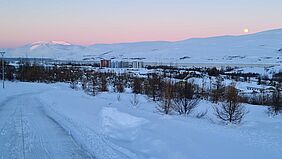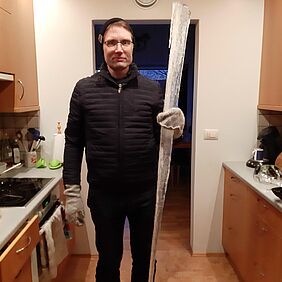We continue travelling across Europe to discover the energy sources and usage in the SMARCTIC project partner regions during winter months. This week we move to Iceland, where our project partner Ragnar Asmundsson, from Orkusetur Energy Agency, shares some interesting facts and knowledge.
Even though temperatures in Iceland can be low throughout the year, our SMARCTIC partner explains that they start feeling winter properly in late October or early November, when darkness creeps in. “At the end of January or early February, we see the sun come up over the mountains and this is the ideal time for skiing and other snow-related adventures”, he adds. Nevertheless, he mentions, in response to a question on ‘snow energy’, that even if they get a lot of snow during winter, they don’t produce energy from melting snow. “Melting picks up energy. There are some old stories about people bringing water from below frozen lakes into their huts to keep them at 0°C, but it is likely that those stories originate from e.g., Finland, where the coldest period is longer and more continuous. Kids eat the snow and claim they get energy from it!”.
Apart from temperatures, the average of daylight hours during winter months deeply influences the Icelandic people’s habits and routines and, in consequence, the time spent indoors and the energy consumption. “In the northern part of Iceland, close to 66°N, the sun stays below the horizon in mid-winter all 24 hours. However, due to the sun’s grazing angle of incidence, we get the ‘grey sky’ for a number of hours. The darkest time is of course defined at Christmas, +/- 1 month”. Furthermore, at nights, temperature in winter can drop to -20°C. This situation makes Icelandic people stay indoors for longer periods of time and, consequently, the energy consumption increases considerably. According to Ragnar, “a standard family may only go outside for work and shopping. Therefore, most people spend their fortune on their houses, making them as comfortable as possible”. The energy consumption is high; however, they use either geothermal water directly or hydro powered electricity for heating. Therefore, the heating is 100% sustainable and without use of fossil fuel. “We admit of course that we may be ‘over-enjoying’ this luxury and many households have their own small spa or hot pot outside. We can shower and bathe without regrets and the internet bill is usually higher than the heating cost. Youngsters in Iceland do not experience cold anymore, - temperature is stable year-round in all houses, regulated with water radiators that receive ca. 70°C hot water, either geothermal water directly or via a district heating centre which regulates the temperature with heat exchangers. The time spent indoors may be a health concern, and SMARCTIC addresses the air quality issues in combination with heating energy consumption”.
Ragnar adds that most people take care of heating their houses, since it will otherwise be uncomfortably cold inside. He mentions that indoor temperature ranges between 18-23°C, depending on the house owner’s level of comfort. “The average house owner is however usually not too concerned about air quality, and we just open the windows if the air quality is not sufficient. This ‘manual regulation’ can waste energy and SMARCTIC sensors and devices help to address both issues: preserve air quality without wasting too much energy”.
Asked about how the weather also impacts their lifestyle, Ragnar Asmundsson highlights that, living on an island, the temperature is dominated by sea temperature. “Due to the Gulf Stream, we get relatively warm air flowing over all the time, with somewhat stable temperature annual ocean currents. This creates good conditions for fish and other ocean creatures we feast on, and share with our neighbours, mostly UK markets nowadays but also bacalao for the Spanish, the latter trade has been around for centuries”.
Strategies and targets for reducing energy expenditure
Ragnar mentions that the district heating companies sometimes send out warnings prior to forecasted cold spells, asking their customers to be careful with water consumption. “The outside swimming halls are often closed if temperature drops below -10°C. We normally try to obey but since heating energy is low-costs, incentives are often lacking, and this situation has very small effects on our ‘heat-comfort standard’”.
Finally, our partner confirms their approach in the project. “In SMARCTIC, we are focusing on using smart sensors and devices to monitor air quality in children’s environment. Children normally do not speak up on those issues and automation will therefore take care of them”.


